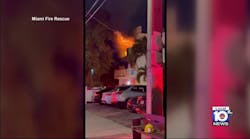An emergency radio scanner crackles. An alarm sounds. Fire police officers suit up, jump into their vehicles and rush to the scene.
The only problem is that fire police, and their fellow firefighters, often forget to do the very thing they ask of other drivers -- buckle their seat belts.
Then, instead of being the rescuers, they can become the victims.
Take the case of Edgar Scott, a 75-year-old Menands volunteer fire police captain, who died when his box-van collided with a propane tanker while making a U-turn on Interstate 787. Scott, who was not wearing a seat belt, was tossed from his vehicle.
Scott and other fire police -- who are in charge of crowd and traffic control at emergency scenes -- account for the largest percentage of on-duty deaths for those in the fire service industry, including paid and volunteer.
And, among both fire police and firefighters killed, failing to wear seat belts already has been cited more often this year than last, according to the United States Fire Administration. Of nine killed this year, six were not wearing seat belts and were thrown from their vehicles. Of the eight who died in 2006, two were not wearing seat belts. The worst year in the past five was in 2003, when 30 were killed, eight of whom were not wearing seat belts.
"This is a huge problem," said Kelvin Cochran, second vice president of the International Association of Fire Chiefs, a nonprofit professional association of more than 12,000. "We've seen enough deaths this year. We need to take drastic measures to change this trend."
A seat belt mandate is not on the books for fire departments in New York. Actually, the state is one of 37 that does not mandate seat belt use for all firefighters, according to 2003 figures from Critical Incident Stress Management Perspectives Inc., a training and consulting practice that prepares fire departments for deaths among its membership.
The state's seat belt laws include an emergency responder exemption that excuses firefighters and fire police from buckling up. According to the Fireman's Association of the State of New York, the exemption exists because every second counts and being held up by a seat belt could cost a life.
But the anti-seat belt use rationale could be deeper than that. Members of fire departments believe they are immune to injury, said Daniel McGuire, president of Critical Incident, which was recently hired by the New York State Association of Fire Chiefs to give three-hour workshops to every county in New York until 2008.
"They think nothing is going to happen to (them)," he said. "There's a real machismo attitude."
That occurs against a backdrop of New York having more on-duty fatalities overall than any other state last year. Fourteen died, accounting for 13.3 percent of deaths nationwide, the national fire administration reports. From 2001 to 2006, there were 59 on-duty fatalities in New York (excluding deaths during the terrorist attacks of Sept. 11, 2001).
Among fire service deaths nationally, some 25 percent occur when firefighters and fire police are responding to or returning from incidents, the national fire administration reports.
In a November 2003 poll by Firehouse.com -- a Web site used by firefighters and fire chiefs -- more than 11,000 people responded to the topic of seat belt usage. Forty-five percent answered they don't wear seat belts at all times when responding to emergencies. In the same poll from April, 36 percent of 8,000 people said they don't wear seat belts.
Wynantskill fire police Capt. Richard Trumbull, who requires seat belt usage at his fire department, doesn't understand why this is happening.
"It's common sense," he said. "If you want to survive, then you need to wear a seat belt."
Nationwide campaigns are pressing fire departments to require seat belt usage.
The "Everyone Goes Home Tour," started by the National Fallen Firefighters Foundation, aims to reduce the number of fire service on-duty deaths by urging such safety protocols as seat belt usage. The nonprofit foundation based in Emmitsburg, Md., was created by Congress.
Dr. Burton A. Clark, a volunteer firefighter in Laurel, Md., started another campaign pushing fire departments across the nation to wear seat belts. Clark started the National Seat Belt Pledge after Christopher Brian Hunton, 27, of the Amarillo, Texas, fire department died in April 2005 from injuries suffered in an accident. He was not wearing his seat belt. So far, 28,000 firefighters have signed the pledge vowing to buckle up.
"This is something we can stop overnight," Clark said. "Most fire departments have rules, but they don't enforce, they just ignore it. Consequently, it creates a culture of unsafe behavior."
Cochran's solution for seat-belt awareness at his fire department in Shreveport, La., is a three-strike rule that could result in a fine or suspension by the third infraction. No one has received a third strike.
The National Fire Protection Association -- an international nonprofit organization that advocates fire prevention and public safety out of its Quincy, Mass., headquarters -- has a national seat belt policy that many fire departments have adopted. The policy states: "All persons riding in fire apparatus shall be seated and belted securely by seat belts in approved riding positions at any time the vehicle is in motion."
While the Capital Region continues to mourn the death of Scott, many fire police and firefighters are voicing a need for change and more safety awareness among their peers.
"You need to be safe yourself before you can help others," said Brooke Wagner, a fire police officer at the Averill Park & Sand Lake Fire Department.
Courtesy The Times Union
Related Stories





